BRCA1/2 Serves as a Biomarker for Poor Prognosis in Breast Carcinoma
Abstract
1. Introduction
2. Results
2.1. BRCA1/2 Expression in Human Breast Cancer
2.2. Clinicopathological Parameters of BRCA1/2 in BRCA Patients
2.3. Prognostic Value of BRCA1/2 mRNA Expression in BRCA Patients
2.4. The Relationship of BRCA1/2 Mutations and Copy Number Alterations (CNAs) in Breast Cancer
2.5. Co-Expression Analysis of BRCA1/2
2.6. Analysis of GO and KEGG Pathway for BRCA1/2
2.7. Identification of BRCA1/2 Interacting Genes and Proteins and Genetic Alterations
3. Discussion
4. Material and Methods
4.1. Patient Datasets
4.2. Transcript Expression Analysis Using Oncomine Platform
4.3. TIMER 2.0 Analysis
4.4. Expression of BRCA1/2 in BRCA Based on Sample Types by UALCAN
4.5. Analysis of Gene Expression and Mutation Alterations Using cBioPortal
4.6. Correlation Analysis of BRCA1/2 and Breast Cancer Stage
4.7. Prognosis Analysis Using PrognoScan
4.8. Survival Analysis Using Kaplan–Meier Plotter
4.9. Survival and Correlation Analysis Using R2
4.10. GO and KEGG Enrichment Analysis
4.11. Analysis of BRCA1/2 Interacting Genes and Proteins
4.12. Statistical Analysis
Author Contributions
Funding
Data Availability Statement
Acknowledgments
Conflicts of Interest
Statement of Ethics
References
- De Santis, C.; Siegel, R.; Bandi, P.; Jemal, A. Breast cancer statistics, 2011. CA Cancer J. Clin. 2011, 61, 409–418. [Google Scholar]
- Sakamoto, K.; Schmidt, J.W.; Wagner, K.U. Mouse models of breast cancer. Methods Mol. Biol. 2015, 1267, 47–71. [Google Scholar] [PubMed]
- Apostolou, P.; Fostira, F. Hereditary breast cancer: The era of new susceptibility genes. Biomed. Res. Int. 2013, 2013, 747318. [Google Scholar] [CrossRef] [PubMed]
- Narod, S.A.; Salmena, L. BRCA1 and BRCA2 mutations and breast cancer. Discov. Med. 2011, 12, 445–453. [Google Scholar] [PubMed]
- Zhu, Y.; Wu, J.; Zhang, C.; Sun, S.; Zhang, J.; Liu, W.; Zhang, Z.; Huang, J. BRCA mutations and survival in breast cancer: An updated systematic review and meta-analysis. Oncotarget 2016, 7, 70113–70127. [Google Scholar] [CrossRef]
- Hall, J.M.; Lee, M.K.; Newman, B.; Morrow, J.E.; Anderson, L.A.; Huey, B.; King, M.-C. Linkage of early-onset familial breast cancer to chromosome 17q21. Science 1990, 250, 1684–1689. [Google Scholar] [CrossRef]
- Narod, S.A.; Feunteun, J.; Lynch, H.T.; Watson, P.; Conway, T.; Lynch, J.; Lenoir, G.M. Familial breast-ovarian cancer locus on chromosome 17q12-q23. Lancet 1991, 338, 82–83. [Google Scholar] [CrossRef]
- Hall, J.M.; Friedman, L.; Guenther, C.; Lee, M.K.; Weber, J.L.; Black, D.M.; King, M.C. Closing in on a breast cancer gene on chromosome 17q. Am. J. Hum. Genet. 1992, 50, 1235–1242. [Google Scholar]
- Wooster, R.; Neuhausen, S.L.; Mangion, J.; Quirk, Y.; Ford, D.; Collins, N.; Nguyen, K.; Seal, S.; Tran, T.; Averill, D.; et al. Localization of a breast cancer susceptibility gene, BRCA2, to chromosome 13q12-13. Science 1994, 265, 2088–2090. [Google Scholar] [CrossRef]
- Claus, E.B.; Risch, N.; Thompson, W.D. Genetic analysis of breast cancer in the cancer and steroid hormone study. Am. J. Hum. Genet. 1991, 48, 232–242. [Google Scholar]
- Foulkes, W.D. BRCA1 and BRCA2: Chemosensitivity, treatment outcomes and prognosis. Fam. Cancer 2006, 5, 135–142. [Google Scholar] [CrossRef] [PubMed]
- Rebbeck, T.R.; Friebel, T.; Lynch, H.T.; Neuhausen, S.L.; van’t Veer, L.; Garber, J.E.; Evans, G.R.; Narod, S.A.; Isaacs, C.; Matloff, E.; et al. Bilateral prophylactic mastectomy reduces breast cancer risk in BRCA1 and BRCA2 mutation carriers: The PROSE Study Group. J. Clin. Oncol. 2004, 22, 1055–1062. [Google Scholar] [CrossRef] [PubMed]
- Ford, D.; Easton, D.F.; Stratton, M.; Narod, S.; Goldgar, D.; Devilee, P.; Bishop, T.; Weber, B.; Lenoir, G.; Chang-Claude, J.; et al. Genetic heterogeneity and penetrance analysis of the BRCA1 and BRCA2 genes in breast cancer families. The Breast Cancer Linkage Consortium. Am. J. Hum. Genet. 1998, 62, 676–689. [Google Scholar] [CrossRef]
- Easton, D.F.; Narod, S.A.; Ford, D.; Steel, M. The genetic epidemiology of BRCA1. Breast Cancer Linkage Consortium. Lancet 1994, 344, 761. [Google Scholar] [CrossRef]
- Zhang, F.; Ma, J.; Wu, J.; Ye, L.; Cai, H.; Xia, B.; Yu, X. PALB2 links BRCA1 and BRCA2 in the DNA-damage response. Curr. Biol. 2009, 19, 524–529. [Google Scholar] [CrossRef] [PubMed]
- Huynh, M.-M.; Pambid, M.R.; Jayanthan, A.; Dorr, A.; Los, G.; Dunn, S.E. The dawn of targeted therapies for triple negative breast cancer (TNBC): A snapshot of investigational drugs in phase I and II trials. Expert Opin. Investig. Drugs. 2020, 29, 1199–1208. [Google Scholar] [CrossRef]
- Easton, D.F.; Pharoah, P.D.; Antoniou, A.C.; Tischkowitz, M.; Tavtigian, S.V.; Nathanson, K.L.; Devilee, P.; Meindl, A.; Couch, F.J.; Southey, M.; et al. Gene-panel sequencing and the prediction of breast-cancer risk. N. Engl. J. Med. 2015, 372, 2243–2257. [Google Scholar] [CrossRef]
- van den Broek, A.J.; Schmidt, M.K.; van’t Veer, L.J.; Tollenaar, R.A.; van Leeuwen, F.E. Worse breast cancer prognosis of BRCA1/BRCA2 mutation carriers: What’s the evidence? A systematic review with meta-analysis. PLoS ONE 2015, 10, e0120189. [Google Scholar] [CrossRef]
- Yoshida, R. Hereditary breast and ovarian cancer (HBOC): Review of its molecular characteristics, screening, treatment, and prognosis. Breast Cancer 2021, 28, 1167–1180. [Google Scholar] [CrossRef]
- Baretta, Z.; Mocellin, S.; Goldin, E.; Olopade, O.I.; Huo, D. Effect of BRCA germline mutations on breast cancer prognosis: A systematic review and meta-analysis. Medicine 2016, 95, e4975. [Google Scholar] [CrossRef]
- Milne, R.L.; Osorio, A.; Cajal, T.R.; Vega, A.; Llort, G.; de la Hoya, M.; Diez, O.; Alonso, M.C.; Lazaro, C.; Blanco, I.; et al. The average cumulative risks of breast and ovarian cancer for carriers of mutations in BRCA1 and BRCA2 attending genetic counseling units in Spain. Clin. Cancer Res. 2008, 14, 2861–2869. [Google Scholar] [CrossRef] [PubMed]
- Hamann, U.; Sinn, H.P. Survival and tumor characteristics of German hereditary breast cancer patients. Breast Cancer Res. Treat. 2000, 59, 185–192. [Google Scholar] [CrossRef] [PubMed]
- Robson, M.E.; Chappuis, P.O.; Satagopan, J.; Wong, N.; Boyd, J.; Goffin, J.R.; Hudis, C.; Roberge, D.; Norton, L.; Bégin, L.R.; et al. A combined analysis of outcome following breast cancer: Differences in survival based on BRCA1/BRCA2 mutation status and administration of adjuvant treatment. Breast Cancer Res. 2004, 6, R8–R17. [Google Scholar] [CrossRef] [PubMed]
- Moller, P.; Evans, D.G.; Reis, M.M.; Gregory, H.; Anderson, E.; Maehle, L.; Lalloo, F.; Howell, A.; Apold, J.; Clark, N.; et al. Surveillance for familial breast cancer: Differences in outcome according to BRCA mutation status. Int. J. Cancer 2007, 121, 1017–1020. [Google Scholar] [CrossRef]
- Nilsson, M.P.; Hartman, L.; Idvall, I.; Kristoffersson, U.; Johannsson, O.T.; Loman, N. Long-term prognosis of early-onset breast cancer in a population-based cohort with a known BRCA1/2 mutation status. Breast Cancer Res. Treat. 2014, 144, 133–142. [Google Scholar] [CrossRef][Green Version]
- Loman, N.; Johannsson, O.; Bendahl, P.-O.; Dahl, N.; Einbeigi, Z.; Gerdes, A.-M.; Borg, A.; Olsson, H. Prognosis and clinical presentation of BRCA2-associated breast cancer. Eur. J. Cancer 2000, 36, 1365–1373. [Google Scholar] [CrossRef]
- Arun, B.; Bayraktar, S.; Liu, D.D.; Barrera, A.M.G.; Atchley, D.; Pusztai, L.; Litton, J.K.; Valero, V.; Meric-Bernstam, F.; Hortobagyi, G.N.; et al. Response to neoadjuvant systemic therapy for breast cancer in BRCA mutation carriers and noncarriers: A single-institution experience. J. Clin. Oncol. 2011, 29, 3739–3746. [Google Scholar] [CrossRef]
- Huzarski, T.; Byrski, T.; Gronwald, J.; Górski, B.; Domagala, P.; Cybulski, C.; Oszurek, O.; Szwiec, M.; Gugała, K.; Stawicka, M.; et al. Ten-year survival in patients with BRCA1-negative and BRCA1-positive breast cancer. J. Clin. Oncol. 2013, 31, 3191–3196. [Google Scholar] [CrossRef]
- Tryggvadottir, L.; Olafsdottir, E.J.; Olafsdottir, G.H.; Sigurdsson, H.; Johannsson, O.T.; Bjorgvinsson, E.; Alexiusdottir, K.; Stefansson, O.A.; Agnarsson, B.A.; Narod, S.A.; et al. Tumour diploidy and survival in breast cancer patients with BRCA2 mutations. Breast Cancer Res. Treat. 2013, 140, 375–384. [Google Scholar] [CrossRef]
- Sambiasi, D.; Lambo, R.; Pilato, B.; Tommasi, S.; Trojano, G.; Kardhashi, A.; Digennaro, M.; Trojano, V.; Simone, G.; Paradiso, A. BRCA1/2 and clinical outcome in a monoinstitutional cohort of women with hereditary breast cancer. Oncol. Rep. 2014, 31, 365–369. [Google Scholar] [CrossRef][Green Version]
- Marcus, J.N.; Watson, P.; Page, D.L.; Narod, S.A.; Lenoir, G.M.; Tonin, P.; Linder-Stephenson, L.; Salerno, G.; Conway, T.A.; Lynch, H.T. Hereditary breast cancer: Pathobiology, prognosis, and BRCA1 and BRCA2 gene linkage. Cancer 1996, 77, 697–709. [Google Scholar] [CrossRef]
- Veronesi, A.; De Giacomi, C.; Magri, M.D.; Lombardi, D.; Zanetti, M.; Scuderi, C.; Dolcetti, R.; Viel, A.; Crivellari, D.; Bidoli, E.; et al. Familial breast cancer: Characteristics and outcome of BRCA 1-2 positive and negative cases. BMC Cancer 2005, 5, 70. [Google Scholar] [CrossRef] [PubMed][Green Version]
- Gonzalez-Angulo, A.M.; Timms, K.M.; Liu, S.; Chen, H.; Litton, J.K.; Potter, J.; Lanchbury, J.S.; Stemke-Hale, K.; Hennessy, B.T.; Arun, B.K.; et al. Incidence and outcome of BRCA mutations in unselected patients with triple receptor-negative breast cancer. Clin. Cancer Res. 2011, 17, 1082–1089. [Google Scholar] [CrossRef] [PubMed]
- Foulkes, W.D.; Shuen, A.Y. In brief: BRCA1 and BRCA2. J. Pathol. 2013, 230, 347–349. [Google Scholar] [CrossRef]
- Zhao, W.; Steinfeld, J.B.; Liang, F.; Chen, X.; Maranon, D.G.; Ma, C.J.; Kwon, Y.; Rao, T.; Wang, W.; Sheng, C.; et al. BRCA1-BARD1 promotes RAD51-mediated homologous DNA pairing. Nature 2017, 550, 360–365. [Google Scholar] [CrossRef]
- Lee, A.S.; Ang, P. Breast-cancer risk in families with mutations in PALB2. N. Engl. J. Med. 2014, 371, 1650–1651. [Google Scholar]
- Xia, B.; Sheng, Q.; Nakanishi, K.; Ohashi, A.; Wu, J.; Christ, N.; Liu, X.; Jasin, M.; Couch, F.J.; Livingston, D.M. Control of BRCA2 cellular and clinical functions by a nuclear partner, PALB2. Mol. Cell 2006, 22, 719–729. [Google Scholar] [CrossRef]
- Sy, S.M.; Huen, M.S.; Zhu, Y.; Chen, J. PALB2 regulates recombinational repair through chromatin association and oligomerization. J. Biol. Chem. 2009, 284, 18302–18310. [Google Scholar] [CrossRef]
- Tischkowitz, M.; Xia, B. PALB2/FANCN: Recombining cancer and Fanconi anemia. Cancer Res. 2010, 70, 7353–7359. [Google Scholar] [CrossRef]
- Lee, J.O.; Kang, M.J.; Byun, W.S.; Kim, S.A.; Seo, I.H.; Han, J.A.; Moon, J.W.; Kim, J.H.; Kim, S.J.; Lee, E.J.; et al. Metformin overcomes resistance to cisplatin in triple-negative breast cancer (TNBC) cells by targeting RAD51. Breast Cancer Res. 2019, 21, 115. [Google Scholar] [CrossRef]
- San Filippo, J.; Sung, P.; Klein, H. Mechanism of eukaryotic homologous recombination. Annu. Rev. Biochem. 2008, 77, 229–257. [Google Scholar] [CrossRef] [PubMed]
- Hong, K.J.; Hsu, M.C.; Hung, W.C. RECK impedes DNA repair by inhibiting the erbB/JAB1/Rad51 signaling axis and enhances chemosensitivity of breast cancer cells. Am. J. Cancer Res. 2015, 5, 2422–2430. [Google Scholar] [PubMed]
- Xiao, G.; Lundine, D.; Annor, G.K.; Canar, J.; Ellison, V.; Polotskaia, A.; Donabedian, P.L.; Reiner, T.; Khramtsova, G.; Olopade, O.I.; et al. Gain-of-Function Mutant p53 R273H Interacts with Replicating DNA and PARP1 in Breast Cancer. Cancer Res. 2020, 80, 394–405. [Google Scholar] [CrossRef] [PubMed]
- Simbulan, C.M.; Suzuki, M.; Izuta, S.; Sakurai, T.; Savoysky, E.; Kojima, K.; Miyahara, K.; Shizuta, Y.; Yoshida, S. Poly(ADP-ribose) polymerase stimulates DNA polymerase alpha by physical association. J. Biol. Chem. 1993, 268, 93–99. [Google Scholar] [CrossRef]
- Simbulan-Rosenthal, C.M.; Rosenthal, D.S.; Hilz, H.; Hickey, R.; Malkas, L.; Applegren, N.; Wu, Y.; Bers, A.G.; Smulson, M.E. The expression of poly(ADP-ribose) polymerase during differentiation-linked DNA replication reveals that it is a component of the multiprotein DNA replication complex. Biochemistry 1996, 35, 11622–11633. [Google Scholar] [CrossRef]
- Tomczak, K.; Czerwińska, P.; Wiznerowicz, M. The Cancer Genome Atlas (TCGA): An immeasurable source of knowledge. Contemp. Oncol. 2015, 19, A68. [Google Scholar] [CrossRef]
- Rhodes, D.R.; Yu, J.; Shanker, K.; Deshpande, N.; Varambally, R.; Ghosh, D.; Barrette, T.; Pander, A.; Chinnaiyan, A.M. ONCOMINE: A cancer microarray database and integrated data-mining platform. Neoplasia 2004, 6, 1–6. [Google Scholar] [CrossRef]
- Li, T.; Fu, J.; Zeng, Z.; Cohen, D.; Li, J.; Chen, Q.; Li, B.; Liu, X.S. TIMER2.0 for analysis of tumor-infiltrating immune cells. Nucleic Acids Res. 2020, 48, W509–W514. [Google Scholar] [CrossRef]
- Chandrashekar, D.S.; Bashel, B.; Balasubramanya, S.A.H.; Creighton, C.J.; Ponce-Rodriguez, I.; Chakravarthi, B.V.S.K.; Varambally, S. UALCAN: A Portal for Facilitating Tumor Subgroup Gene Expression and Survival Analyses. Neoplasia 2017, 19, 649–658. [Google Scholar] [CrossRef]
- Cerami, E.; Gao, J.; Dogrusoz, U.; Gross, B.E.; Sumer, S.O.; Aksoy, B.A.; Jacobsen, A.; Byrne, C.J.; Heuer, M.L.; Larsson, E.; et al. The cBio cancer genomics portal: An open platform for exploring multidimensional cancer genomics data. Cancer Discov. 2012, 2, 401–404. [Google Scholar] [CrossRef]
- Mizuno, H.; Kitada, K.; Nakai, K.; Sarai, A. PrognoScan: A new database for meta-analysis of the prognostic value of genes. BMC Med. Genom. 2019, 2, 18. [Google Scholar] [CrossRef] [PubMed]
- Lanczky, A.; Nagy, A.; Bottai, G.; Munkacsy, G.; Szabo, A.; Santarpia, L.; Gyorffy, B. miRpower: A web-tool to validate survival-associated miRNAs utilizing expression data from 2178 breast cancer patients. Breast Cancer Res. Treat. 2016, 160, 439–446. [Google Scholar] [CrossRef] [PubMed]
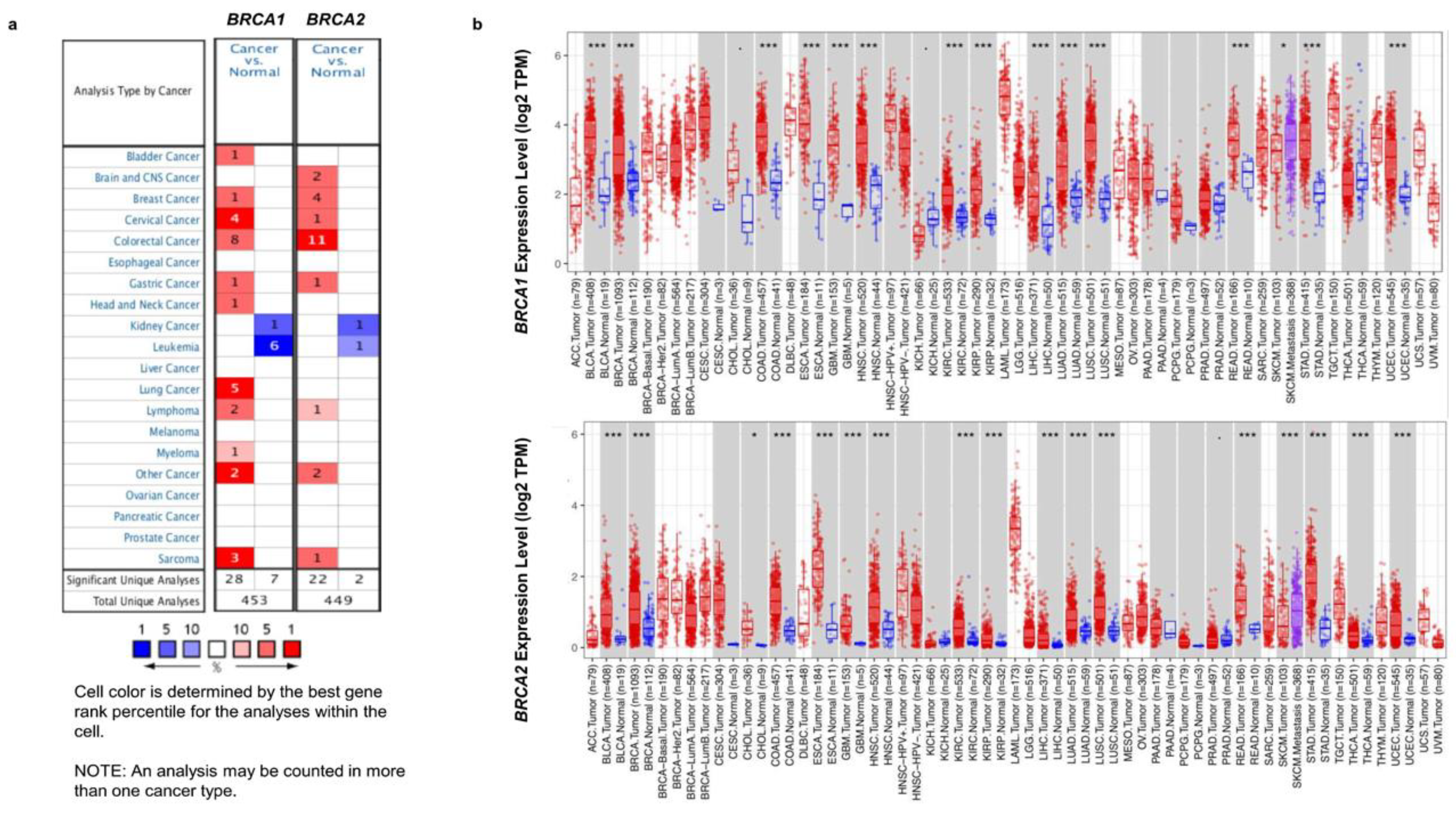
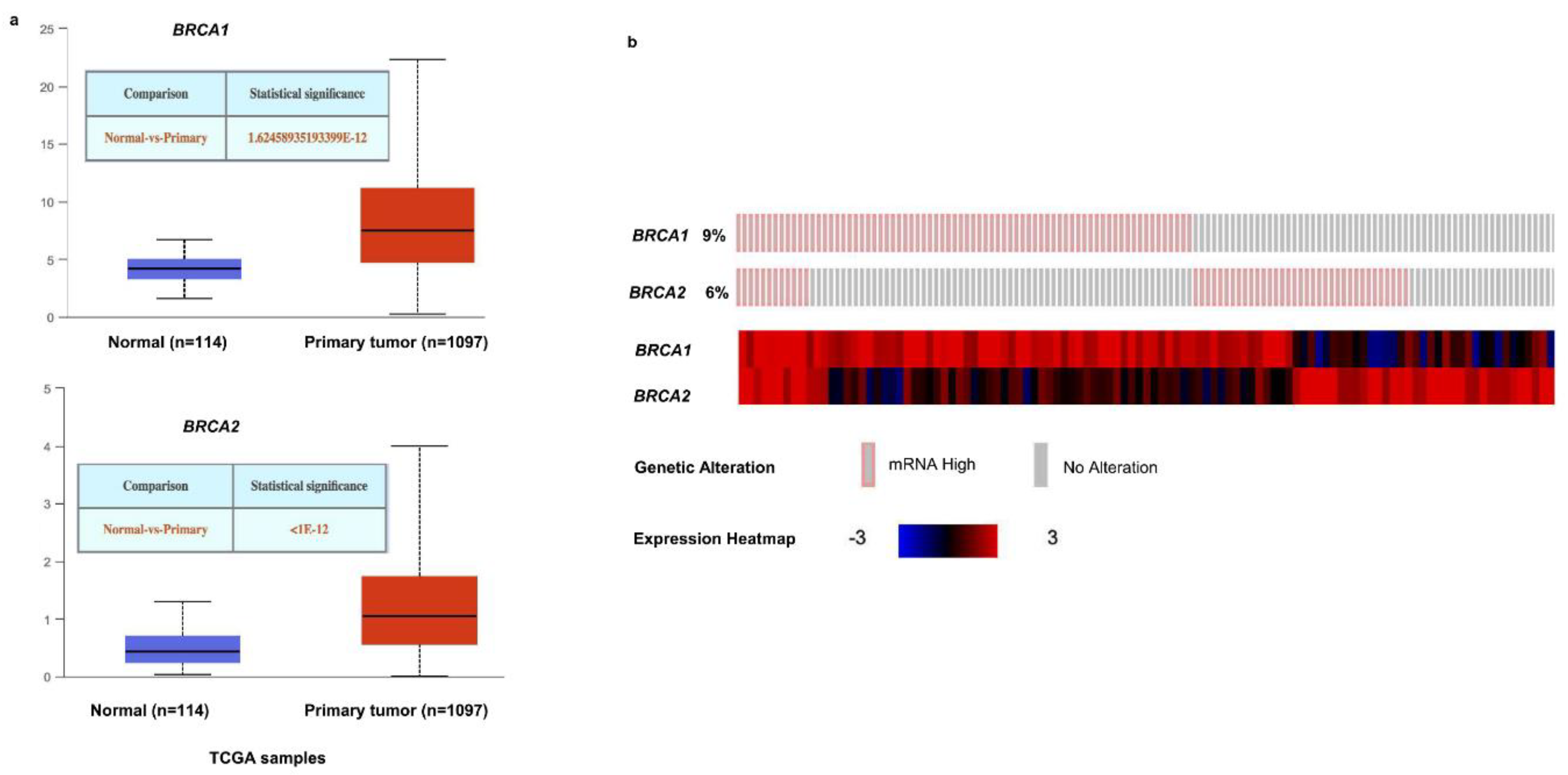
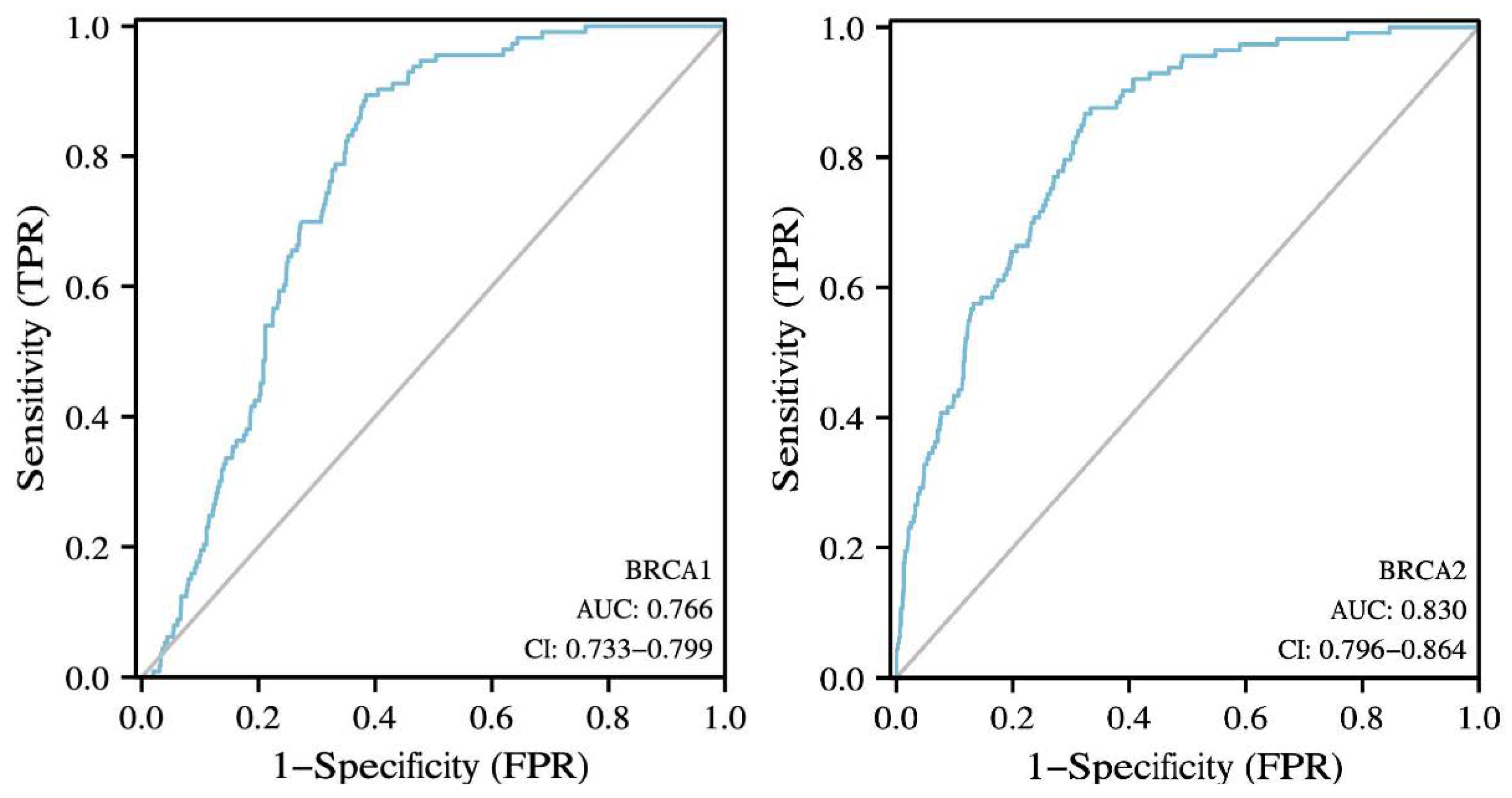
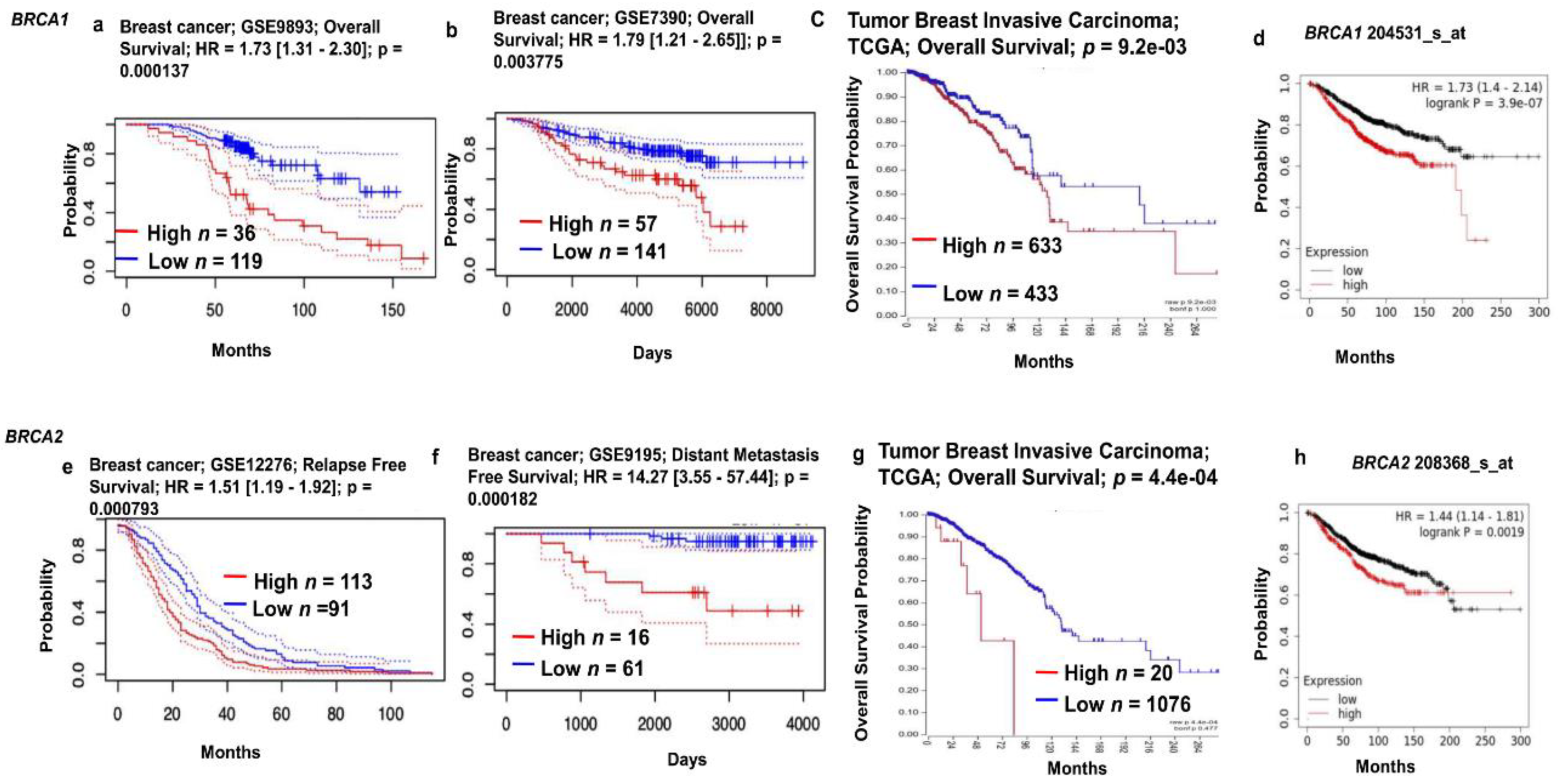
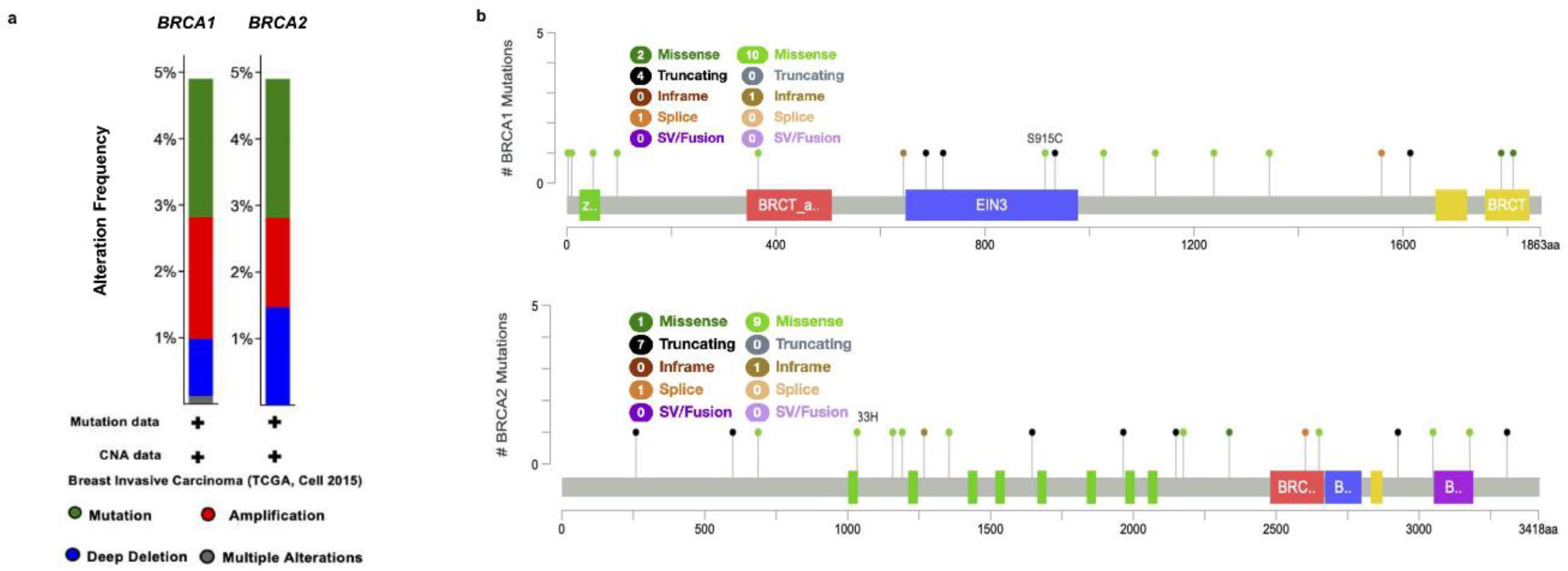
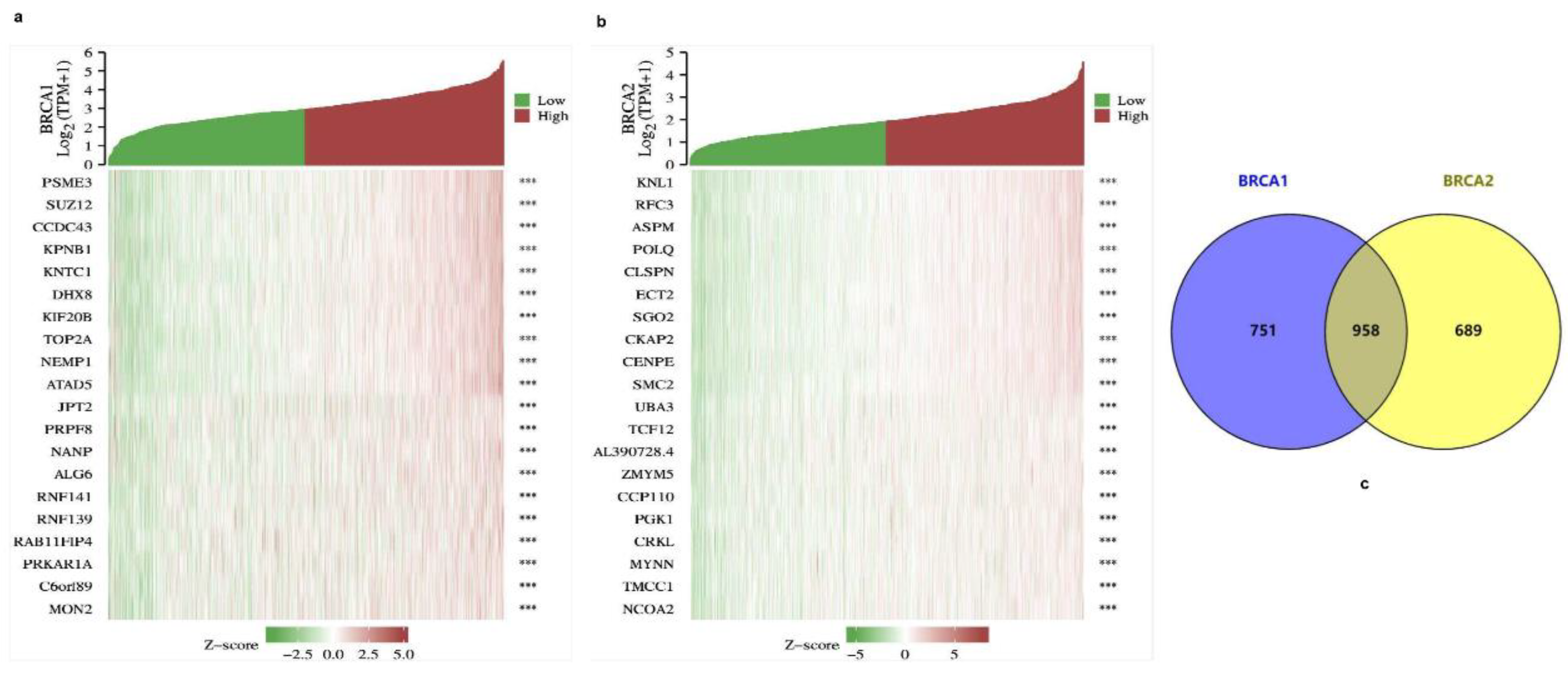


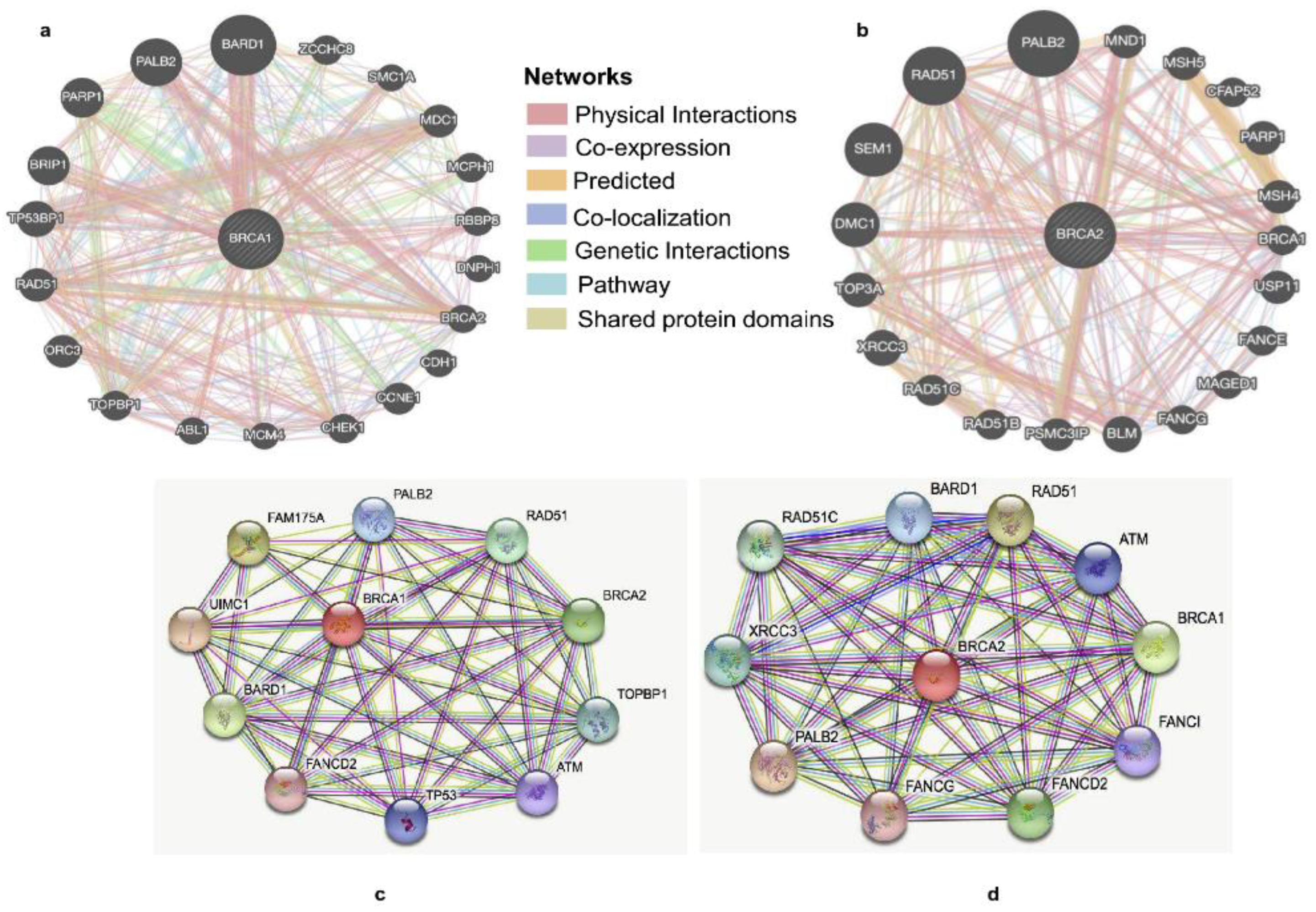
| Gene Name | Types of BRCA vs. Normal | Fold Change | t Test | p Value | Reference |
|---|---|---|---|---|---|
| BRCA1 | Intraductal Cribriform Breast Adenocarcinoma vs. Normal | 3.454 | 15.862 | 1.92 × 10−6 | TCGA Breast |
| BRCA2 | Mucinous Breast Carcinoma vs. Normal | 3.750 | 9.344 | 3.22 × 10−5 | TCGA Breast |
| Invasive Breast Carcinoma vs. Normal | 2.602 | 9.978 | 5.91 × 10−18 | TCGA Breast | |
| Invasive Ductal Breast Carcinoma vs. Normal | 3.214 | 14.586 | 1.46 × 10−25 | TCGA Breast | |
| Invasive Lobular Breast Carcinoma vs. Normal | 2.124 | 6.314 | 9.36 × 10−9 | TCGA Breast |
| Variables | No. | BRCA1 (p Value) | BRCA2 (p Value) |
|---|---|---|---|
| Age | NS | p < 0.01 | |
| ≤60 | 601 | ||
| >60 | 482 | ||
| T-Stage | NS | NS | |
| T1 | 277 | ||
| T2 | 629 | ||
| T3 | 139 | ||
| T4 | 35 | ||
| N-Stage | p < 0.05 | p < 0.01 | |
| N0 | 514 | ||
| N1 | 358 | ||
| N2 | 116 | ||
| N3 | 76 | ||
| M-Stage | NS | NS | |
| M0 | 902 | ||
| M1 | 20 | ||
| ER status | p < 0.01 | p < 0.001 | |
| − | 240 | ||
| + | 793 | ||
| PR status | p < 0.001 | p < 0.001 | |
| − | 342 | ||
| + | 688 | ||
| HER2 status | NS | p < 0.01 | |
| − | 558 | ||
| + | 157 | ||
| PAM (50) | p < 0.001 | p < 0.001 | |
| Lum A | 562 | ||
| Lum B | 204 | ||
| Her 2 | 82 | ||
| Basal | 195 | ||
| Normal | 40 |
Publisher’s Note: MDPI stays neutral with regard to jurisdictional claims in published maps and institutional affiliations. |
© 2022 by the authors. Licensee MDPI, Basel, Switzerland. This article is an open access article distributed under the terms and conditions of the Creative Commons Attribution (CC BY) license (https://creativecommons.org/licenses/by/4.0/).
Share and Cite
Jin, T.Y.; Park, K.S.; Nam, S.E.; Yoo, Y.B.; Park, W.S.; Yun, I.J. BRCA1/2 Serves as a Biomarker for Poor Prognosis in Breast Carcinoma. Int. J. Mol. Sci. 2022, 23, 3754. https://doi.org/10.3390/ijms23073754
Jin TY, Park KS, Nam SE, Yoo YB, Park WS, Yun IJ. BRCA1/2 Serves as a Biomarker for Poor Prognosis in Breast Carcinoma. International Journal of Molecular Sciences. 2022; 23(7):3754. https://doi.org/10.3390/ijms23073754
Chicago/Turabian StyleJin, Tong Yi, Kyoung Sik Park, Sang Eun Nam, Young Bum Yoo, Won Seo Park, and Ik Jin Yun. 2022. "BRCA1/2 Serves as a Biomarker for Poor Prognosis in Breast Carcinoma" International Journal of Molecular Sciences 23, no. 7: 3754. https://doi.org/10.3390/ijms23073754
APA StyleJin, T. Y., Park, K. S., Nam, S. E., Yoo, Y. B., Park, W. S., & Yun, I. J. (2022). BRCA1/2 Serves as a Biomarker for Poor Prognosis in Breast Carcinoma. International Journal of Molecular Sciences, 23(7), 3754. https://doi.org/10.3390/ijms23073754







